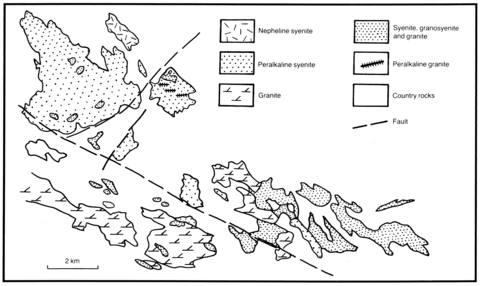stripes
This intrusion, which has an area of 75 km2, is located in the most northerly part of Tuva on the southern slope of the East Sayan ridge. The intrusion cuts Proterozoic crystalline schists and dolomitic marbles, lower Palaeozoic gabbroids and plagiogranites and Cambrian and Devonian volcanic and sedimentary rocks The intrusion has a complex form and three intrusive phases can be distinguished. The first, and principal, phase comprises coarse- and medium-grained, massive biotite or hornblende-biotite granites, leucocratic and mesocratic pyroxene (augite) or biotite-pyroxene syenites, and occasionally amphibole peralkaline syenites and mesocratic, sometimes trachytic, nepheline syenites with Na-hedenbergite, aegirine-diopside and biotite. The rocks of the first phase comprise about 80% of the outcropping intrusive rocks. Rocks of the second intrusive phase are represented by fine- or medium-grained or porphyritic granosyenites and granites in which the dark minerals may be biotite, hornblende or alkaline amphibole. Small, fine-grained dykes, the third intrusive phase, of riebeckite granite sometimes have a gneissose structure. Petrographic and chemical studies by Kotina et al. (1971) led them to suggest that pre-magmatic metasomatic processes were responsible for differences between the various rock types.
DMITRE'EV, L.V. and KOTINA, R.P. 1966. Morphology and structural position of the Katun alkaline intrusion from East Sayan. Sovetskaya Geologiya, Moskva, 9: 106-23.
KOTINA, R.P., KREMNEVA, M.A. and POPOVA, R.P. 1971. Some peculiarities of the metasomatic syenitization process and the formation of alkaline melts exemplified by the Katunsk massif (eastern Tuva). Geokhimiya. Academiya Nauk SSSR, Moskva, 980-91.

